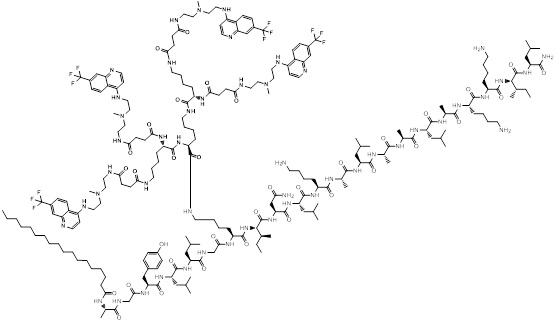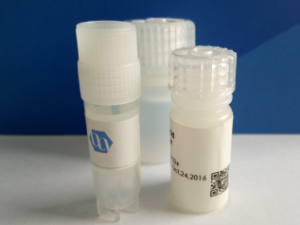$ 1,380.0
Quantity: 5 MG
In stock
Description
Product name: PepFect 6
Catalog#: 1101011
Synonyms: PepFect-6, PF6, Stearyl-AGYLLGK*(εNH)INLKALAALAKKIL
Sequence: Stearyl-Ala-Gly-Tyr-Leu-Leu-Gly-Lys(QN4-MAP4)-Ile-Asn-Leu-Lys-Ala-Leu-Ala-Ala-Leu-Ala-Lys-Lys-Ile-Leu-NH2
Modifications: N-terminal Stearic Acid, C-terminal amide,
M.W: 2842.39
M.F.: C141H240F3N31O26
Purity: 90%
Counter ion: Trifluoacetate
Format: Lyophilized powder
Description: PepFect 6 (PF6), a novel CPP, comprising the previously reported stearyl-TP10 peptide, having pH titratable trifluoromethylquinoline moieties covalently incorporated to facilitate endosomal release. Stable PF6/siRNA nanoparticles enter entire cell populations and rapidly promote endosomal escape, resulting in robust RNAi responses in various cell types (including primary cells), with minimal associated transcriptomic or proteomic changes. Furthermore, PF6-mediated delivery is independent of cell confluence and, in most cases, not significantly hampered by serum proteins. Finally, these nanoparticles promote strong RNAi responses in different organs following systemic delivery in mice without any associated toxicity. Strikingly, similar knockdown in liver is achieved by PF6/siRNA nanoparticles and siRNA injected by hydrodynamic infusion, a golden standard technique for liver transfection. These results imply that the peptide, in addition to having utility for RNAi screens in vitro, displays therapeutic potential. The structure of PF6 is based on that for PF3 with the addition of covalently linked, titratable, trifluoromethylquinoline moieties. Trifluoromethylquinoline is an analog of chloroquine which is the lysosomotropic agent, inhibiting endosome acidification, leading to endosomal swelling and rupture. As it has been shown, co-incubation of TP10‐oligonucleotide complex with quinacrine greatly increased the efficiency of the splice correction by cargo oligonucleotide. Therefore, including the analog of quinacrine into the PF3 structure thus obtaining PF6 seemed a logical development. As a result, in comparison to TP10 and PF3, PF6 is much more potent delivery vector for siRNA in vitro and in vivo, presumably by trifluoromethylquinoline promoted escape from endosomes by osmotic swelling and thus decreasing endosomal breakdown of CPPs and cargo by delaying endosome acidification.


